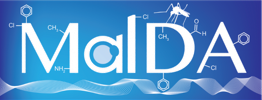Lysyl-tRNA synthetase as a drug target in malaria and cryptosporidiosis.
-
Journal Article
-
Research Support, N.I.H., Extramural
-
Research Support, Non-U.S. Gov't
-
Research Support, U.S. Gov't, Non-P.H.S.
Journal:
Proceedings of the National Academy of Sciences of the United States of America, Volume: 116, Issue: 14
Authors:
Beatriz Baragaña B, Barbara Forte B, Ryan Choi R, Stephen Nakazawa Hewitt S, Juan A Bueren-Calabuig JA, João Pedro Pisco JP, Caroline Peet C, David M Dranow DM, David A Robinson DA, Chimed Jansen C, Neil R Norcross NR, Sumiti Vinayak S, Mark Anderson M, Carrie F Brooks CF, Caitlin A Cooper CA, Sebastian Damerow S, Michael Delves M, Karen Dowers K, James Duffy J, Thomas E Edwards TE, Irene Hallyburton I, Benjamin G Horst BG, Matthew A Hulverson MA, Liam Ferguson L, María Belén Jiménez-Díaz MB, Rajiv S Jumani RS, Donald D Lorimer DD, Melissa S Love MS, Steven Maher S, Holly Matthews H, Case W McNamara CW, Peter Miller P, Sandra O'Neill S, Kayode K Ojo KK, Maria Osuna-Cabello M, Erika Pinto E, John Post J, Jennifer Riley J, Matthias Rottmann M, Laura M Sanz LM, Paul Scullion P, Arvind Sharma A, Sharon M Shepherd SM, Yoko Shishikura Y, Frederick R C Simeons FRC, Erin E Stebbins EE, Laste Stojanovski L, Ursula Straschil U, Fabio K Tamaki FK, Jevgenia Tamjar J, Leah S Torrie LS, Amélie Vantaux A, Benoît Witkowski B, Sergio Wittlin S, Manickam Yogavel M, Fabio Zuccotto F, Iñigo Angulo-Barturen I, Robert Sinden R, Jake Baum J, Francisco-Javier Gamo FJ, Pascal Mäser P, Dennis E Kyle DE, Elizabeth A Winzeler EA, Peter J Myler PJ, Paul G Wyatt PG, David Floyd D, David Matthews D, Amit Sharma A, Boris Striepen B, Christopher D Huston CD, David W Gray DW, Alan H Fairlamb AH, Andrei V Pisliakov AV, Chris Walpole C, Kevin D Read KD, Wesley C Van Voorhis WC, Ian H Gilbert IH
Abstract:
Malaria and cryptosporidiosis, caused by apicomplexan parasites, remain major drivers of global child mortality. New drugs for the treatment of malaria and cryptosporidiosis, in particular, are of high priority; however, there are few chemically validated targets. The natural product cladosporin is active against blood- and liver-stage and in cell-culture studies. Target deconvolution in has shown that cladosporin inhibits lysyl-tRNA synthetase (KRS1). Here, we report the identification of a series of selective inhibitors of apicomplexan KRSs. Following a biochemical screen, a small-molecule hit was identified and then optimized by using a structure-based approach, supported by structures of both KRS1 and KRS (KRS). In vivo proof of concept was established in an SCID mouse model of malaria, after oral administration (ED = 1.5 mg/kg, once a day for 4 d). Furthermore, we successfully identified an opportunity for pathogen hopping based on the structural homology between KRS1 and KRS. This series of compounds inhibit KRS and and in culture, and our lead compound shows oral efficacy in two cryptosporidiosis mouse models. X-ray crystallography and molecular dynamics simulations have provided a model to rationalize the selectivity of our compounds for KRS1 and KRS vs. (human) KRS. Our work validates apicomplexan KRSs as promising targets for the development of drugs for malaria and cryptosporidiosis.
Courtesy of the U.S. National Library of Medicine
